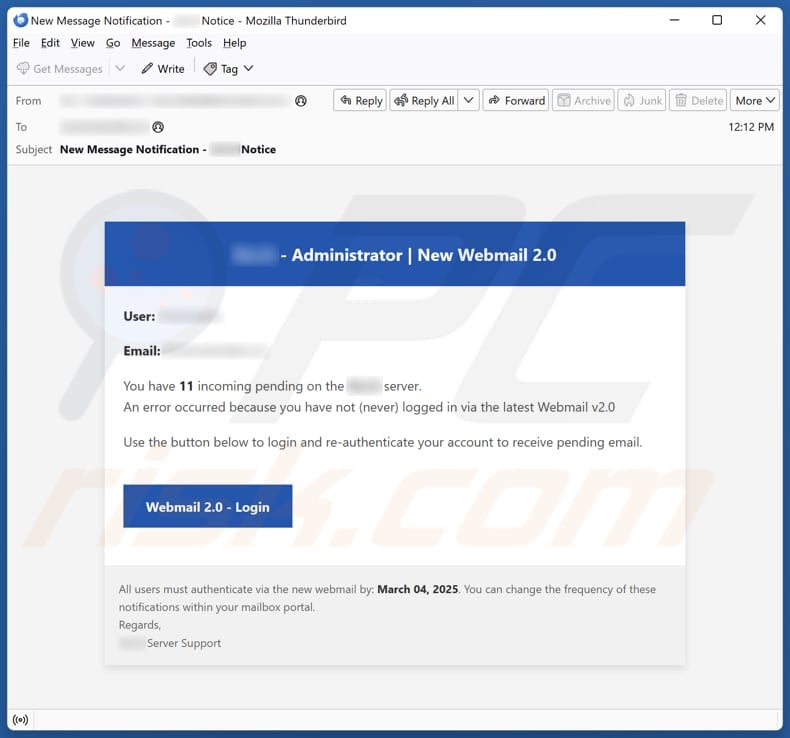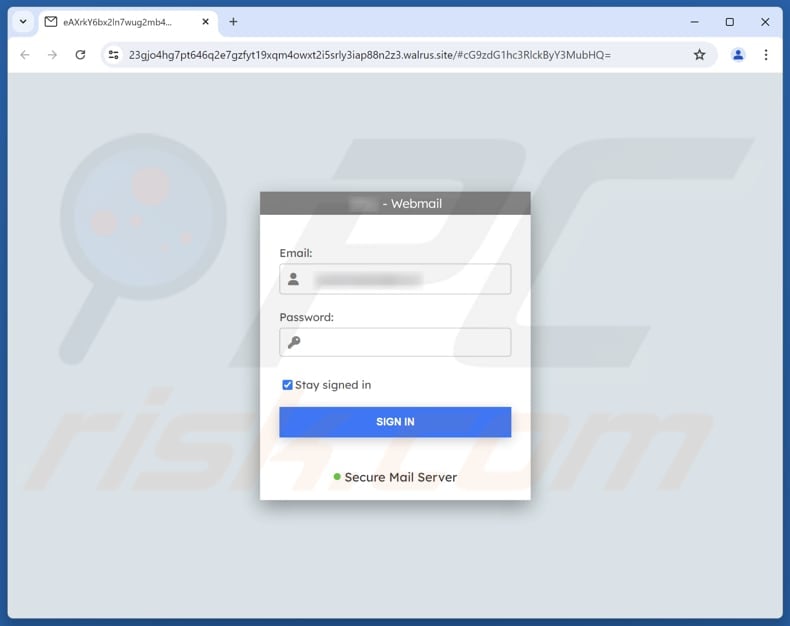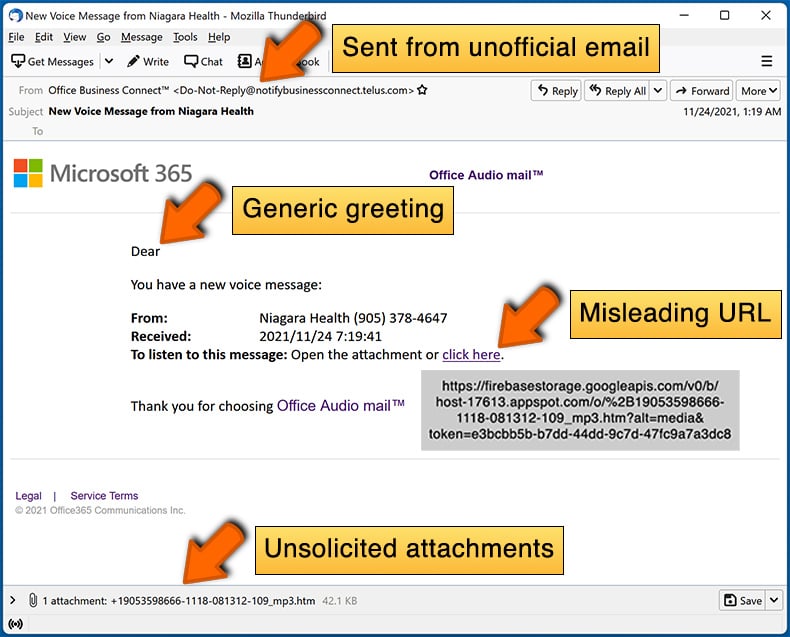How to recognize scams like "New Webmail 2.0"
Phishing/ScamAlso Known As: New Webmail 2.0 phishing email
Get free scan and check if your device is infected.
Remove it nowTo use full-featured product, you have to purchase a license for Combo Cleaner. Seven days free trial available. Combo Cleaner is owned and operated by RCS LT, the parent company of PCRisk.com.
What kind of scam is "New Webmail 2.0"?
We have inspected the email and found that it is a fake email regarding pending emails and email account re-authentication. It is a phishing email designed to trick recipients into opening a deceptive web page and disclosing personal information. Emails of this type should be ignored to avoid data theft and other potential issues.

More about the "New Webmail 2.0" scam email
This phishing email poses as a notification from an email administrator. It claims that the recipient has 11 pending messages on the server. It states that an error occurred because the user has never logged into the latest Webmail v2.0 system. To "resolve" the issue, the email instructs the recipient to click a provided button to log in and "re-authenticate" their account.
Furthermore, it urges recipients to complete this authentication process by a specified deadline and warns that failure to do so could impact email access. Clicking the provided button ("Webmail 2.0 - Login") leads to a fake Webmail sign-in website instructing visitors to enter their email address and password (email account login credentials).
This information, if entered, is then transmitted to scammers who can misuse it for malicious purposes. For instance, they can access email accounts and harvest personal information, send scam emails to others, distribute malware, or engage in other malicious activities. Furthermore, scammers may try to access other accounts, including social media, gaming, and banking.
Additionally, fraudsters might sell the stolen information to third parties. Given these risks, it is important to recognize phishing emails, never respond to them, and not disclose personal information when encountering such emails (or on websites opened through them).
| Name | New Webmail 2.0 Email Scam |
| Threat Type | Phishing, Scam, Social Engineering, Fraud |
| Fake Claim | You have 11 incoming messages pending |
| Related Domain | walrus[.]site |
| Detection Names | Fortinet (Phishing), Full List Of Detections (VirusTotal) |
| Disguise | Notification from the email service provider |
| Symptoms | Unauthorized online purchases, changed online account passwords, identity theft, illegal access of the computer. |
| Distribution methods | Deceptive emails, rogue online pop-up ads, search engine poisoning techniques, misspelled domains. |
| Damage | Loss of sensitive private information, monetary loss, identity theft. |
| Malware Removal (Windows) |
To eliminate possible malware infections, scan your computer with legitimate antivirus software. Our security researchers recommend using Combo Cleaner. Download Combo CleanerTo use full-featured product, you have to purchase a license for Combo Cleaner. 7 days free trial available. Combo Cleaner is owned and operated by RCS LT, the parent company of PCRisk.com. |
Similar scam emails in general
Phishing emails attempt to deceive recipients by posing as trusted entities. They often appear urgent and pressure users to enter personal details on fake websites or provide sensitive information directly via email. Falling for these scams can lead to account compromise, financial loss, identity theft, or even malware infections.
More examples of scam emails targeting personal information are "Trust Wallet Sign-In Attempt", "Capital One - Card Restricted Email Scam", and "Login From A New Device".
How do spam campaigns infect computers?
Threat actors often use email to distribute malware by attaching infected files such as MS Office documents, PDFs, script files, archives, or executables. Opening these attachments can result in instant infection, while some files require further interaction, like enabling macros in a compromised Office document, to deploy the threat.
Deceptive emails may also contain links leading to malicious websites. Once visited, these pages can initiate automatic malware downloads, or they can be designed to trick users into installing harmful software manually.
How to avoid installation of malware?
Be cautious with unexpected emails from unknown senders, especially those containing links or attachments. Do not open links or files in emails of this kind. Keep your operating system and applications up to date, and perform regular scans with a reliable security tool to maintain device protection.
Only download software or files from trusted official websites or app stores, and avoid clicking pop-ups, ads, or links found on suspicious sites. Never grant notification permissions to untrustworthy websites. If you have already opened malicious attachments, we recommend running a scan with Combo Cleaner Antivirus for Windows to automatically eliminate infiltrated malware.
Text presented in the "New Webmail 2.0" email letter:
Subject: New Message Notification - ******** Notice
******** - Administrator | New Webmail 2.0User: Postmaster
Email: ********
You have 11 incoming pending on the ******** server.
An error occurred because you have not (never) logged in via the latest Webmail v2.0Use the button below to login and re-authenticate your account to receive pending email.
Webmail 2.0 - LoginAll users must authenticate via the new webmail by: March 04, 2025. You can change the frequency of these notifications within your mailbox portal.
Regards,
******** Server Support
Phishing website used in this scam:

Instant automatic malware removal:
Manual threat removal might be a lengthy and complicated process that requires advanced IT skills. Combo Cleaner is a professional automatic malware removal tool that is recommended to get rid of malware. Download it by clicking the button below:
DOWNLOAD Combo CleanerBy downloading any software listed on this website you agree to our Privacy Policy and Terms of Use. To use full-featured product, you have to purchase a license for Combo Cleaner. 7 days free trial available. Combo Cleaner is owned and operated by RCS LT, the parent company of PCRisk.com.
Quick menu:
- What is New Webmail 2.0 phishing email?
- Types of malicious emails.
- How to spot a malicious email?
- What to do if you fell for an email scam?
Types of malicious emails:
![]() Phishing Emails
Phishing Emails
Most commonly, cybercriminals use deceptive emails to trick Internet users into giving away their sensitive private information, for example, login information for various online services, email accounts, or online banking information.
Such attacks are called phishing. In a phishing attack, cybercriminals usually send an email message with some popular service logo (for example, Microsoft, DHL, Amazon, Netflix), create urgency (wrong shipping address, expired password, etc.), and place a link which they hope their potential victims will click on.
After clicking the link presented in such email message, victims are redirected to a fake website that looks identical or extremely similar to the original one. Victims are then asked to enter their password, credit card details, or some other information that gets stolen by cybercriminals.
![]() Emails with Malicious Attachments
Emails with Malicious Attachments
Another popular attack vector is email spam with malicious attachments that infect users' computers with malware. Malicious attachments usually carry trojans that are capable of stealing passwords, banking information, and other sensitive information.
In such attacks, cybercriminals' main goal is to trick their potential victims into opening an infected email attachment. To achieve this goal, email messages usually talk about recently received invoices, faxes, or voice messages.
If a potential victim falls for the lure and opens the attachment, their computers get infected, and cybercriminals can collect a lot of sensitive information.
While it's a more complicated method to steal personal information (spam filters and antivirus programs usually detect such attempts), if successful, cybercriminals can get a much wider array of data and can collect information for a long period of time.
![]() Sextortion Emails
Sextortion Emails
This is a type of phishing. In this case, users receive an email claiming that a cybercriminal could access the webcam of the potential victim and has a video recording of one's masturbation.
To get rid of the video, victims are asked to pay a ransom (usually using Bitcoin or another cryptocurrency). Nevertheless, all of these claims are false - users who receive such emails should ignore and delete them.
How to spot a malicious email?
While cyber criminals try to make their lure emails look trustworthy, here are some things that you should look for when trying to spot a phishing email:
- Check the sender's ("from") email address: Hover your mouse over the "from" address and check if it's legitimate. For example, if you received an email from Microsoft, be sure to check if the email address is @microsoft.com and not something suspicious like @m1crosoft.com, @microsfot.com, @account-security-noreply.com, etc.
- Check for generic greetings: If the greeting in the email is "Dear user", "Dear @youremail.com", "Dear valued customer", this should raise suspiciousness. Most commonly, companies call you by your name. Lack of this information could signal a phishing attempt.
- Check the links in the email: Hover your mouse over the link presented in the email, if the link that appears seems suspicious, don't click it. For example, if you received an email from Microsoft and the link in the email shows that it will go to firebasestorage.googleapis.com/v0... you shouldn't trust it. It's best not to click any links in the emails but to visit the company website that sent you the email in the first place.
- Don't blindly trust email attachments: Most commonly, legitimate companies will ask you to log in to their website and to view any documents there; if you received an email with an attachment, it's a good idea to scan it with an antivirus application. Infected email attachments are a common attack vector used by cybercriminals.
To minimise the risk of opening phishing and malicious emails we recommend using Combo Cleaner Antivirus for Windows.
Example of a spam email:

What to do if you fell for an email scam?
- If you clicked on a link in a phishing email and entered your password - be sure to change your password as soon as possible. Usually, cybercriminals collect stolen credentials and then sell them to other groups that use them for malicious purposes. If you change your password in a timely manner, there's a chance that criminals won't have enough time to do any damage.
- If you entered your credit card information - contact your bank as soon as possible and explain the situation. There's a good chance that you will need to cancel your compromised credit card and get a new one.
- If you see any signs of identity theft - you should immediately contact the Federal Trade Commission. This institution will collect information about your situation and create a personal recovery plan.
- If you opened a malicious attachment - your computer is probably infected, you should scan it with a reputable antivirus application. For this purpose, we recommend using Combo Cleaner Antivirus for Windows.
- Help other Internet users - report phishing emails to Anti-Phishing Working Group, FBI’s Internet Crime Complaint Center, National Fraud Information Center and U.S. Department of Justice.
Frequently Asked Questions (FAQ)
Why did I receive this email?
Scammers likely sent the same message to numerous recipients. Your email address may have been collected from a data breach, a phishing website, or other deceptive tactics.
I have provided my personal information when tricked by this email, what should I do?
If you have shared your login credentials, change them immediately. Additionally, consider reporting the incident to your email service provider.
I have downloaded and opened a malicious file attached to an email, is my computer infected?
Executable files can trigger infections instantly, while other file types, like documents, may require additional actions (e.g., enabling macros) to deploy malware. The risk of your system being compromised depends on the file type.
I have read the email but did not pen the attachment, is my computer infected?
Simply opening an email is usually not harmful, but clicking links or opening attachments in fraudulent emails can expose you to malware infections and other security threats.
Will Combo Cleaner remove malware infections that were present in email attachment?
Combo Cleaner can identify and remove most known malware, but more sophisticated threats may be deeply embedded in the system. A full system scan is necessary to detect and eliminate these advanced infections.
Share:

Tomas Meskauskas
Expert security researcher, professional malware analyst
I am passionate about computer security and technology. I have an experience of over 10 years working in various companies related to computer technical issue solving and Internet security. I have been working as an author and editor for pcrisk.com since 2010. Follow me on Twitter and LinkedIn to stay informed about the latest online security threats.
PCrisk security portal is brought by a company RCS LT.
Joined forces of security researchers help educate computer users about the latest online security threats. More information about the company RCS LT.
Our malware removal guides are free. However, if you want to support us you can send us a donation.
DonatePCrisk security portal is brought by a company RCS LT.
Joined forces of security researchers help educate computer users about the latest online security threats. More information about the company RCS LT.
Our malware removal guides are free. However, if you want to support us you can send us a donation.
Donate
▼ Show Discussion